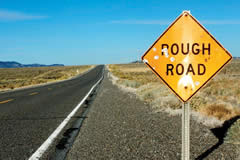5 Tips For Driving On Rough Roads - Vol.220
If you've ever been on a long distance road trip, you can most likely appreciate a well-maintained road. Rough roads are noisy, uncomfortable, and can even be damaging to your vehicle and tires. If you've recently driven through a pothole-ridden area of town, or plan on taking a road trip anytime soon, here are 5 tips to make driving on rough roads a little bit better.

Tip #1. Slow Down
The faster that you go, the less reaction time you'll have to avoid problem areas in the road and plan out the best possible route. Avoiding large bumps, gashes, and holes in the road helps to protect the life of your tire and reduce the strain placed on your vehicles shocks and alignment. You also reduce your risk of hitting a puddled area that could cause your car to slide out of control.
Tip #2. Drive in the Fast Lane
Whenever you drive on an interstate highway, avoid driving in the right lane if you can; some areas have laws about driving in the fast lane unless you are going to pass, others do not. The right lane experiences a lot more wear and tear from tracker trailers and heavy loads wearing down the road from excessive weight. That means that the left lane bound to be in a little better condition even if you are driving in a poorly maintained area. If you are driving in a rural area or dirt road with no one around, steer your car onto the least used parts of the road possible to avoid most of the serious bumps.
Tip #3. Understand Your Vehicle
Understand a little about your vehicle and how it drives. Is your vehicle rear wheel drive, front wheel drive, or all wheel drive? This will determine how well your car handles certain road conditions and what you should do to avoid getting stuck in ruts or muddy roads.
When driving a rear wheel drive car, avoid taking primitive roads that have thick rocks or sand. You could risk getting stuck, or damage the tires from putting excess strain on the two wheels doing most of the work. If you have a four-wheel drive, you'll find that handling primitive or rough roads will be much easier, and you'll have a little bit more flexibility on how you can handle your vehicle and where you can go.
Tip #4. Carry Emergency Equipment
The strain put on your vehicle from driving on rough roads can cause any number of problems to occur, including but not limited to blowing a tire. Carry with you these emergency supplies so that you are prepared incase anything goes wrong:
- Tire Jack
- Shovel
- Jumper Cables
- Spare Tire
- First Aid Kit
- Cell Phone
If you have these items on you, you'll be less likely to find yourself stranded or end up paying someone else to try and get you out.
Tip #5. Modify Your Vehicle
If driving on rough roads is something you do regularly, you should consider making adjustments to your vehicle to make the experience more enjoyable. For one, switch out you can raise your vehicle up using a lift kit and switch out the shocks to a high quality option. This will alleviate much of the bumping around that you feel inside the cabin and make the ride a little bit more comfortable.
Another option you could do is to invest in tires that are designed for off road driving or rough roads in general. These tires will have great traction to increase safety and conform to the materials of the road a little bit better.